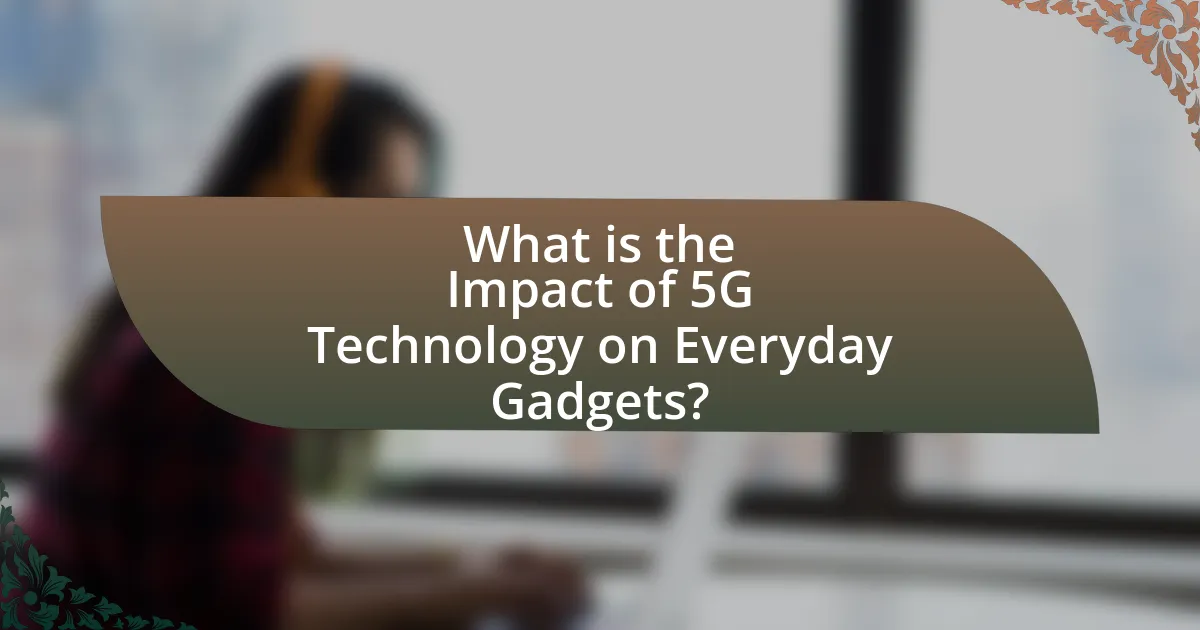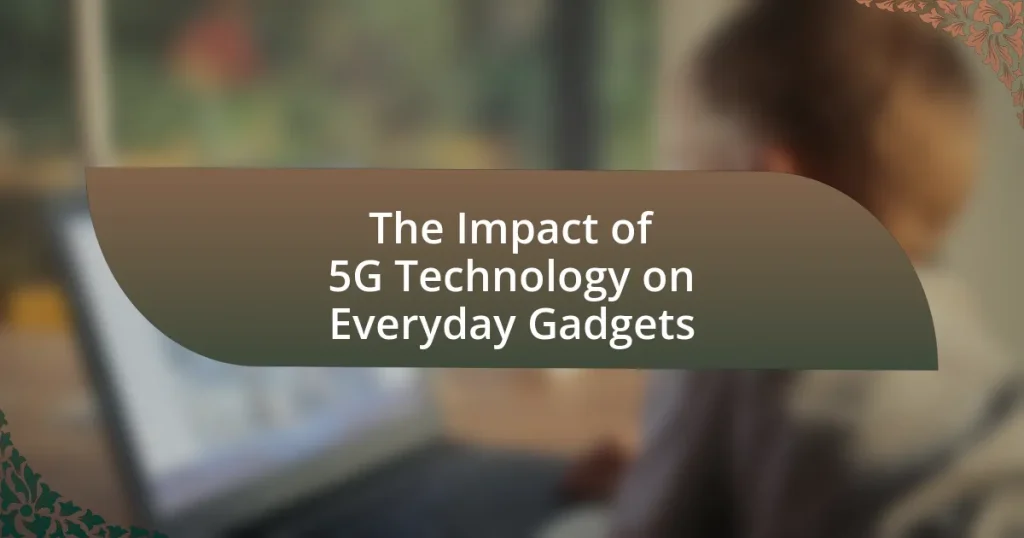The article examines the impact of 5G technology on everyday gadgets, highlighting its ability to enhance functionality through faster data speeds, lower latency, and improved connectivity. It details how 5G differs from previous generations, supporting up to 1 million devices per square kilometer and achieving download speeds of up to 10 Gbps. Key features such as real-time communication and increased capacity are discussed, along with the benefits for consumers, including seamless streaming and enhanced smart home integration. The article also addresses challenges posed by 5G, its influence on the Internet of Things (IoT), and practical tips for consumers to maximize the advantages of this technology in their devices.

What is the Impact of 5G Technology on Everyday Gadgets?
5G technology significantly enhances the functionality and performance of everyday gadgets by providing faster data speeds, lower latency, and improved connectivity. This advancement allows devices such as smartphones, smart home appliances, and wearables to operate more efficiently, enabling real-time data processing and seamless communication. For instance, 5G can support multiple devices simultaneously without degradation in performance, which is crucial for smart homes where numerous gadgets are interconnected. Additionally, studies indicate that 5G can achieve download speeds up to 10 Gbps, compared to 4G’s maximum of 1 Gbps, thereby facilitating high-definition streaming and augmented reality applications on everyday devices.
How does 5G technology differ from previous generations?
5G technology differs from previous generations primarily through its significantly higher data transfer speeds, lower latency, and greater capacity for connected devices. Specifically, 5G can achieve speeds up to 10 Gbps, which is up to 100 times faster than 4G LTE, allowing for seamless streaming and real-time applications. Additionally, 5G reduces latency to as low as 1 millisecond, compared to 30-50 milliseconds for 4G, enhancing responsiveness for applications like gaming and autonomous vehicles. Furthermore, 5G networks can support up to 1 million devices per square kilometer, vastly increasing the number of connected devices compared to earlier technologies, which typically supported around 100,000 devices. These advancements enable new use cases in smart cities, IoT, and enhanced mobile broadband experiences.
What are the key features of 5G technology?
The key features of 5G technology include enhanced data speeds, reduced latency, increased capacity, and improved connectivity. Enhanced data speeds can reach up to 10 Gbps, significantly faster than 4G, enabling quicker downloads and smoother streaming. Reduced latency, often as low as 1 millisecond, allows for real-time communication, which is crucial for applications like autonomous vehicles and remote surgeries. Increased capacity supports a higher number of connected devices simultaneously, facilitating the Internet of Things (IoT) expansion. Improved connectivity ensures more reliable connections in densely populated areas, addressing the growing demand for mobile data. These features collectively transform how everyday gadgets operate, enhancing user experiences and enabling new functionalities.
How does 5G enhance connectivity for everyday gadgets?
5G enhances connectivity for everyday gadgets by providing significantly higher data speeds, lower latency, and increased capacity compared to previous generations of mobile networks. This technology allows devices such as smart home appliances, wearables, and IoT devices to communicate more efficiently and effectively, enabling real-time data exchange and improved user experiences. For instance, 5G can support up to one million devices per square kilometer, facilitating seamless connectivity in densely populated areas. Additionally, the reduced latency of around 1 millisecond enables instant responses, which is crucial for applications like remote surgery or autonomous vehicles.
What are the potential benefits of 5G technology for consumers?
5G technology offers consumers significantly faster data speeds, with potential peak speeds reaching up to 10 Gbps, which is up to 100 times faster than 4G. This increased speed enables seamless streaming of high-definition content, quicker downloads, and enhanced online gaming experiences. Additionally, 5G’s lower latency, which can be as low as 1 millisecond, improves real-time communication and responsiveness in applications such as virtual reality and augmented reality. Furthermore, 5G supports a greater number of connected devices simultaneously, facilitating the growth of smart home technologies and the Internet of Things (IoT), thereby enhancing consumer convenience and automation in daily life.
How does 5G improve the performance of smart devices?
5G significantly enhances the performance of smart devices by providing faster data transfer speeds, lower latency, and increased connectivity. With speeds reaching up to 10 Gbps, 5G allows smart devices to process and transmit data more efficiently, enabling real-time applications such as augmented reality and remote control of devices. The reduced latency, often below 1 millisecond, ensures that commands sent to smart devices are executed almost instantaneously, improving user experience. Additionally, 5G supports a higher density of connected devices, allowing more smart devices to operate simultaneously without network congestion, which is crucial for smart homes and IoT ecosystems.
What new functionalities can be expected from gadgets with 5G?
Gadgets with 5G technology can be expected to offer enhanced functionalities such as significantly faster data transfer speeds, lower latency, and improved connectivity for a larger number of devices simultaneously. These advancements enable features like real-time augmented reality applications, seamless 4K and 8K video streaming, and enhanced smart home integration. For instance, 5G networks can support download speeds exceeding 1 Gbps, which is crucial for applications requiring high bandwidth, such as virtual reality gaming and telemedicine. Additionally, the reduced latency of around 1 millisecond allows for instantaneous communication between devices, facilitating innovations in autonomous vehicles and remote surgery.
What challenges does 5G technology present for everyday gadgets?
5G technology presents several challenges for everyday gadgets, primarily due to its higher frequency bands and increased complexity. These challenges include limited range and penetration, as 5G signals struggle to pass through obstacles like walls, which can lead to connectivity issues in urban environments. Additionally, the need for more infrastructure, such as small cell towers, increases deployment costs and may not be feasible in all areas. Furthermore, existing gadgets may require upgrades or replacements to be compatible with 5G networks, leading to increased consumer costs and electronic waste.
How does the rollout of 5G affect existing devices?
The rollout of 5G affects existing devices primarily by enhancing their connectivity capabilities and performance. Devices that support 5G can experience significantly faster data speeds, reduced latency, and improved overall network efficiency compared to previous generations like 4G. For example, 5G technology can enable download speeds exceeding 1 Gbps, which is up to 100 times faster than 4G, allowing for smoother streaming and quicker downloads on compatible devices. However, devices that do not support 5G will continue to operate on existing networks, potentially limiting their performance and access to new features that leverage 5G capabilities. This transition may also lead to a gradual obsolescence of older devices as consumers seek to take advantage of the benefits offered by 5G technology.
What security concerns arise with the adoption of 5G technology?
The adoption of 5G technology raises significant security concerns, primarily due to its increased connectivity and reliance on software. The expanded attack surface allows for more potential vulnerabilities, making devices more susceptible to cyberattacks. For instance, the integration of Internet of Things (IoT) devices in 5G networks can lead to unauthorized access and data breaches, as many IoT devices lack robust security measures. Additionally, the use of network slicing in 5G can create isolated virtual networks, but if not properly secured, these slices can be exploited by malicious actors to intercept sensitive data. According to a report by the European Union Agency for Cybersecurity, the complexity of 5G networks increases the risk of supply chain attacks, where vulnerabilities in hardware or software components can be exploited.
How is 5G technology influencing the development of new gadgets?
5G technology is significantly influencing the development of new gadgets by enabling faster data transfer speeds, lower latency, and increased connectivity. These advancements allow manufacturers to create devices that can support high-definition streaming, augmented reality, and the Internet of Things (IoT) applications more effectively. For instance, 5G networks can handle up to 1 million devices per square kilometer, facilitating the creation of smart home devices that communicate seamlessly with each other. Additionally, the enhanced bandwidth of 5G supports innovations in wearable technology, such as smartwatches that can stream music and video without relying on a smartphone.
What types of gadgets are being designed specifically for 5G?
Various types of gadgets are being designed specifically for 5G, including smartphones, tablets, smart home devices, wearables, and automotive technology. Smartphones and tablets are being equipped with 5G modems to enable faster data speeds and improved connectivity. Smart home devices, such as security cameras and smart speakers, are being developed to leverage 5G’s low latency for real-time communication. Wearables, including smartwatches and fitness trackers, are integrating 5G capabilities to enhance health monitoring and connectivity. Additionally, automotive technology is advancing with 5G-enabled vehicles that support features like vehicle-to-everything (V2X) communication for improved safety and navigation. These developments are driven by the need for higher bandwidth and lower latency that 5G technology offers, facilitating a new era of connected devices.
How are manufacturers adapting to the 5G landscape?
Manufacturers are adapting to the 5G landscape by redesigning their products to leverage higher speeds and lower latency. This adaptation includes integrating advanced antennas and chipsets that support 5G connectivity, enabling devices to handle increased data traffic efficiently. For instance, smartphone manufacturers like Samsung and Apple have released models equipped with 5G capabilities, reflecting a significant shift in product development strategies to meet consumer demand for faster internet access. Additionally, manufacturers are investing in research and development to create IoT devices that can utilize 5G’s enhanced features, such as real-time data processing and improved connectivity for smart home applications. This strategic focus on 5G technology is essential for maintaining competitiveness in a rapidly evolving market.
What are the implications of 5G technology on the Internet of Things (IoT)?
5G technology significantly enhances the Internet of Things (IoT) by providing faster data transfer speeds, lower latency, and increased connectivity for a vast number of devices. This advancement allows IoT devices to communicate in real-time, enabling applications such as smart cities, autonomous vehicles, and remote healthcare services. For instance, 5G can support up to one million devices per square kilometer, compared to 4G’s limit of around 100,000 devices, facilitating the deployment of dense networks of interconnected devices. Additionally, the reduced latency of 5G, which can be as low as one millisecond, is crucial for applications requiring immediate feedback, such as industrial automation and augmented reality. These implications collectively drive innovation and efficiency across various sectors, transforming how everyday gadgets operate and interact.
How does 5G enhance the functionality of IoT devices?
5G enhances the functionality of IoT devices by providing significantly higher data transfer speeds, lower latency, and increased connectivity. These improvements enable IoT devices to communicate more efficiently and effectively, allowing for real-time data processing and analysis. For instance, 5G can support up to one million devices per square kilometer, which is essential for densely populated areas where many IoT devices operate simultaneously. Additionally, the latency of 5G networks can be as low as one millisecond, facilitating instantaneous communication between devices, which is crucial for applications like autonomous vehicles and remote surgery. This combination of speed, capacity, and responsiveness fundamentally transforms how IoT devices operate, making them more reliable and capable of supporting advanced functionalities.
What role does 5G play in the future of smart homes?
5G plays a crucial role in the future of smart homes by enabling faster data transmission, lower latency, and increased connectivity for a multitude of devices. This advanced network technology supports the seamless integration of smart appliances, security systems, and IoT devices, allowing them to communicate in real-time. For instance, 5G can facilitate high-definition video streaming from security cameras without lag, enhance remote monitoring capabilities, and improve the responsiveness of smart home systems. According to a report by the GSMA, 5G networks are expected to connect over 1.5 billion IoT devices by 2025, highlighting its significance in transforming smart home ecosystems.
What practical tips can consumers follow to maximize the benefits of 5G technology in their gadgets?
To maximize the benefits of 5G technology in their gadgets, consumers should ensure their devices are 5G-compatible and utilize 5G networks whenever available. This compatibility allows users to experience significantly faster download and upload speeds, reduced latency, and improved connectivity. Additionally, consumers can optimize their settings by enabling 5G mode in their device settings, which can enhance performance for data-intensive applications like streaming and gaming. Regularly updating device software is also crucial, as manufacturers often release updates that improve 5G performance and security. According to a report by the GSMA, 5G networks can deliver speeds up to 100 times faster than 4G, making these practices essential for fully leveraging the technology.




